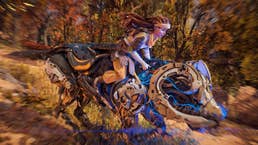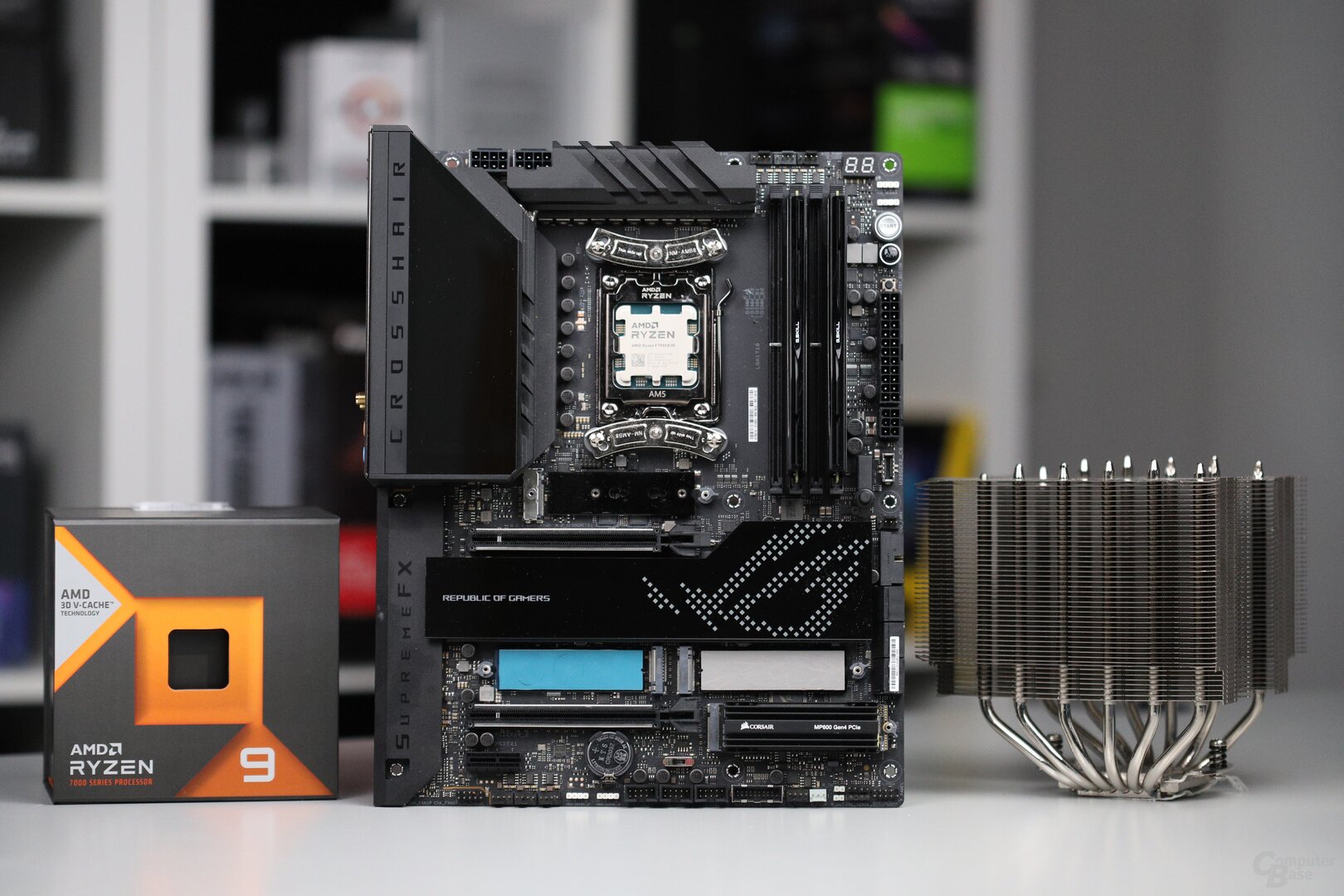No but I will for a 21:9 aspect ratio, better graphics, more responsive input, three times the performance and faster loading.Tbf the 7800x3d+mobo costs as much as a full fat ps5 by itself, so it probably should be faster. But PC is no longer doubling or tripling console performance. Are you really going to spend $2000+ on a pc for 0.9s faster loading?
DF-Horizon Forbidden West PC vs PS5: Enhanced Features, Performance Tests + Image Quality Boosts! |UP| 3/25 PC Benchmarks!
- Thread starter Gamernyc78
- Start date
You are using an out of date browser. It may not display this or other websites correctly.
You should upgrade or use an alternative browser.
You should upgrade or use an alternative browser.
3X the performance? The game plays perfectly fine at 60fps. I like hfr as well but the ps5 definitely is winning the value argument in a way the ps4 never did due to having a bunch of 30fps locked gamesNo but I will for a 21:9 aspect ratio, better graphics, more responsive input, three times the performance and faster loading.
Value doesn't really matter to me, but I'm not everybody.3X the performance? The game plays perfectly fine at 60fps. I like hfr as well but the ps5 definitely is winning the value argument in a way the ps4 never did due to having a bunch of 30fps locked games
The problem with pc gaming is that it requires a lot of people buying the -60 and -70 level cards to support the industry. I just don't see a lot of value in that level of performance right now. If the only people who gamed on pc were the people who buy 4080s and 4090s the pc gaming industry would be dead. I'm someone who would build a high end rig, but I also recognize that if it were just people like me I'd have to spend 10x as much or go without, because the volume sales are what drives revenue.Value doesn't really matter to me, but I'm not everybody.
Which is why there's always a wide array of hardware accounted for when sorting out system requirements. Not everybody wants or can afford the best so there's a multitude of products available for those people that doesn't involve a one month's mortgage payment on a PC.The problem with pc gaming is that it requires a lot of people buying the -60 and -70 level cards to support the industry. I just don't see a lot of value in that level of performance right now. If the only people who gamed on pc were the people who buy 4080s and 4090s the pc gaming industry would be dead. I'm someone who would build a high end rig, but I also recognize that if it were just people like me I'd have to spend 10x as much or go without, because the volume sales are what drives revenue.
Yes very small minority.The problem with pc gaming is that it requires a lot of people buying the -60 and -70 level cards to support the industry. I just don't see a lot of value in that level of performance right now. If the only people who gamed on pc were the people who buy 4080s and 4090s the pc gaming industry would be dead. I'm someone who would build a high end rig, but I also recognize that if it were just people like me I'd have to spend 10x as much or go without, because the volume sales are what drives revenue.
TBF, the CPU is also leveraged for load and decompression. On PS5 the CPU does very little of this as custom silicon in the I/O subsystem handles it. But it'd appear the CPU & GPU being used in the DF testing has more than enough overhead to outdo the I/O subsystem on PS5 for tasks like this. Also possible HFW isn't loading a lot of packed data so decompression of data isn't leveraged too much.
We also don't know what system RAM amounts or speeds DF are using for their PCs in these tests; DDR system RAM could be using some portion as a cache to speed up load times and that will always outperform an SSD. Even data not suspected as being resident in RAM as cache could be present and helping to load in new data.
And well just lastly, it's been four years now. No one was saying PS5's SSD I/O was going to remain fastest on the market the entire gen. But it was definitely faster & better than any solution on PC for at least a year. PC finally pulling ahead after four years isn't really a bragging point TBH.
ARTICLE LINK
Digital Foundry's Alex Battaglia goes into a deep dive interview with multiple people involved in the Horizon: Forbidden West PC Port on both the Guerilla and Nixxes sides of things. It's pretty enlightening to understand how modern PC ports work, at least with bespoke engines such as Guerilla's and Insomniac's.
Digital Foundry's Alex Battaglia goes into a deep dive interview with multiple people involved in the Horizon: Forbidden West PC Port on both the Guerilla and Nixxes sides of things. It's pretty enlightening to understand how modern PC ports work, at least with bespoke engines such as Guerilla's and Insomniac's.
When did work start on Horizon Forbidden West for PC, and what was the working relationship like between Nixxes and Guerrilla?
Patrick Den Bekker - Nixxes: We normally start a project a year before it is released, so that would be February or March last year.

Jeroen Krebbers - Guerrilla: We at Guerrilla internally have a PC version, which is not the same as shipping a PC game... we use that for our internal tooling and also for verifying that our rendering backend and all of our subsystems work on PC, to make sure that can run tooling and bakes and things like that without requiring a PlayStation for everything. And that's usually the basis of starting a port, right? So there's a bunch of legwork that we do internally that is basically handed over to Nixxes, and they do the magic.
The entire article is a really good read. Some interesting insight regarding the state of shader compilation on PC games:A big part of Nixxes ports is supporting ultrawide aspect ratios. What was like from an art perspective, changing scenes designed for 16:9 to support 21:9 and other aspect ratios?

Patrick Den Bekker - Nixxes: Obviously, on all projects we like to have an ultrawide option, and the game content isn't built for that. So we have animators and designers that go through all the cinematic content to make sure it's all clean on the sides - so you don't see popping, or characters not animating. That's usually the most time-intensive part. But it's always a really great addition to PC, so that's why we try to do it.
Julian Huijbregts - Nixxes: It's good to stress that this title has a very large amount of cutscenes. It was quite a big commitment! But we do support up to 32:9, even in cutscenes. By default, the black bars are turned on, which is partly a creative decision as the game is created for 16:9, but do feel free to turn black bars off and enjoy it on your 32:9 monitor, because I think it's quite enjoyable! And yeah, we did put a lot of work into that in terms of art and lighting.
Jeroen Krebbers - Guerrilla: We saw the game at 32:9 here at Guerrilla for the first time only two weeks ago, and it's amazing. Alex, if you haven't seen it yet, please find somewhere where you can see it.
Guerilla also heavily hints at raytracing features coming to the Decima engine in the future, presumably for use in a theoretical PS5 Pro console:Are you happy with that PSO collection process for Forbidden West on PC - could automation be used as well? And how do you feel about the whole PSO issue for Windows gaming in general?
Michiel Roza - Nixxes : We do have an automated collection, which doesn't catch everything, but does make sure the game is in a playable state and QA won't run into a stutter fest every time we change the shaders... I think PSOs are not a great solution. It's the best we have, but I think something else can be done here. I really like the way Valve is handling it on the Steam Deck... and I wonder if that can be extended to PC as well.
Jeroen Krebbers - Guerrilla: Yeah, it would need a lot of collaboration between Microsoft, hardware manufaacturers and software developers to come to an understanding of how this should work. I've jokingly said like "why do we have GPUs that are so fast and yet we can't compile a shader on it?"
Patrick Den Bekker - Nixxes: Compared to consoles, it's actually a big burden on the development project. Whereas on the PS5 you can build them on a build machine and load them in, execute them and you're done, on PC we really need to rely on vendors and caches to get them compiled, and we spent a lot of trouble making sure they're compiled faster. At some point in the project we had one PSO that took 150 seconds... It's not only the collection, it's making sure they can execute fast enough.
Jeroen Krebbers - Guerrilla: As a developer, the PSO situation is very frustrating. We know that it doesn't have to be as bad as it currently is. And it is really bad. It takes a lot of time and effort, and then you compile the same shader on a million different PCs, right? So there's energy waste and things like that.
Was ray tracing considered for Horizon Forbidden West, like the RT shadows in previous Nixxes PC port Shadow of the Tomb Raider?
Michiel Roza - Nixxes : It was definitely considered, and it's good that you mentioned Shadow of the Tomb Raider. There, we had to do an entire lighting pass to get RT shadows to work. And for this project, with the hours of cinematics and the scope... we decided that the game already looks really good, there's a strong direction here and we really didn't want to mess with it.
Jeroen Krebbers - Guerrilla: Don't forget a lot of the content is alpha-tested trees. I mean, a lot. Of course we have settlements and some hard surfaces, but most of it is really hard to ray trace against, even for shadows. There's a lot of content, maybe 100 square kilometres of content or more, and we'd need to go through the whole game... it's just mind-boggling... obviously having the scalability between PS4 and PS5 meant that we wanted to focus on stuff that would work on both PS4 and PS5, that sadly excluded RT. And it's not an easy addition to the PC version. We really like the tech of course. Watch this space.
Last edited:
Confirmation that all Sony games are being developed in parallel for PC and that explain why it's taking so long for games to come out.ARTICLE LINK
Digital Foundry's Alex Battaglia goes into a deep dive interview with multiple people involved in the Horizon: Forbidden West PC Port on both the Guerilla and Nixxes sides of things. It's pretty enlightening to understand how modern PC ports work, at least with bespoke engines such as Guerilla's and Insomniac's.
The entire article is a really good read. Some interesting insight regarding the state of shader compilation on PC games:
Guerilla also heavily hints at raytracing features coming to the Decima engine in the future, presumably for use in a theoretical PS5 Pro console:
PC remains the first priority for Sony, regardless if people actually buy the games or not.
If that’s your takeaway from this interview, I seriously question your comprehension skills.Confirmation that all Sony games are being developed in parallel for PC and that explain why it's taking so long for games to come out.
PC remains the first priority for Sony, regardless if people actually buy the games or not.
I didn't watch it but I assume they're doing the same thing that was done with Rise of the Tomb Raider for Xbox One and Xbox 360.If that’s your takeaway from this interview, I seriously question your comprehension skills.
They ported it in parallel to the development, Crystal Dynamics would send over finished chunks of the code that Nixxes would port on the fly.
Yeah even maxed out it doesn't look much better than on PS5 where it already looked amazing tbf. Also no ray tracing offered.Looks about the same.
I won't ask which SSDs are being compared
Or point out how half a second is nothing.
I'll just say fair enough. It loads quicker
Y...you do know that all games are made on PC...right?Confirmation that all Sony games are being developed in parallel for PC and that explain why it's taking so long for games to come out.
PC remains the first priority for Sony, regardless if people actually buy the games or not.
So it’s a good port this time around? I remember ZD’s port was pretty bad at launch.
Yeah, to put it lightly. It took them 6 months to fix it. This seems to be a way better port by comparison. I have seen folks with FPS drops when using a PS5 controller and further optimizations required for the 4000 series of GPUs and NVIDIA in general.
But nothing as critical as zero dawn. Hopefully ghosts is just as good. Tbh I don't even care how long it takes as long as the ports are quality. If TLOU2 is a thing, hopefully nixes is involved as well.
article link
(original article in german, ran through google translate)
Horizon Forbidden West test: benchmarks (FHD, WQHD & UHD), Frametimes and VRAM
The test system and the benchmark scene
All benchmarks were performed on an AMD Ryzen 9 7950X3D (Test), which was operated with the default settings. As a mainboard, the Asus ROG Crosshair X670E Hero (BIOS 1415) was installed.
AMD Ryzen 9 7950X3D tested
The CPU was cooled by a Noctua NH-D15S with a centrally installed 140 mm fan. 48 GB of memory (G.Skill TridentZ Neo, 2 x 24 GB, DDR5-6000, CL36-36-36-72) were available to the processor. Windows 11 23H2 with all updates and enabled HVCI was installed on an NVMe M.2 SSD with PCIe 4.0. The same was true for the game. Resizable BAR was used on supported graphics cards at both AMD and Nvidia and Intel.
The drivers used
The 20-second test sequence takes place in the Open World after a little over three hours of playing time. Near the town of Fahllicht, Aloy marches along a river. Accordingly, there are many screenspace reflections to be seen in the test sequence, in addition, the visibility is also high and the vegetation is strongly imprinted. The test sequence is not a worst-case scenario, but it is quite an above-average challenging scene.
Driver version Game Ready AMD Radeon Adrenaline 24.3.1 Nvidia GeForce GeForce 551.86 Intel Arc 5379
The graphic details used in the following benchmarks
Resolution Graphic details 1.920 to 1,080 Very high preset 2,560 x 1,440 Very high preset 3.840 to 2.160 High-high preset, DLSS/FSR/XeSS Quality
Benchmarks in Full HD, WQHD and Ultra HD (Update)
The old entry-level graphics card GeForce RTX 3060 with 12 GB is not able to achieve 60 FPS in the test sequence at maximum graphics quality in 1,920 x 1,080, and the same applies to Intel's Arc A770, but most models in the course have no problem. The GeForce RTX 3060 Ti reaches the value in Full HD and the Radeon RX 6650 XT as well as the Radeon RX 7600 exceed the mark. The Radeon RX 6700 XT is already significantly above it.
In 2,560 x 1,440 include the GeForce RTX 4070 and the Radeon RX 7700 XT fast enough, in 3,840 x 2,160 this applies in conjunction with DLSS Quality or FSR Quality from a GeForce RTX 4070 or Radeon RX 7800 XT. If you want to play with a native resolution in Ultra HD, you need a very fast graphics card. Only from a Radeon RX 7900 XT or a GeForce RTX 4080 will 60 frames per second be reached.
(original article in german, ran through google translate)
certainly seems quite well-optimized, especially on AMD cards. For the 7900XT to beat a 4080 Super at 1440p is unexpected; also 6800XT/7800XT beating 3080 by a decent amount at 1440p
Last edited by a moderator:
The game seems to be super optimized for RDNA2.certainly seems quite well-optimized, especially on AMD cards. For the 7900XT to beat a 4080 Super at 1440p is unexpected; also 6800XT/7800XT beating 3080 by a decent amount at 1440p
With the 6800XT being so close to the 7900GRE (same amount of functional units, similar bandwidth, similar clocks), I would expect future driver updates to give RDNA3 cards some boost.
Regardless, it's probably the best looking game of the generation so far, and to see it performing so well in the PC is quite refreshing.
Ive heard it lacks certain optimization on NVIDIA, specially 4000 series. But all in all is a decent start.








